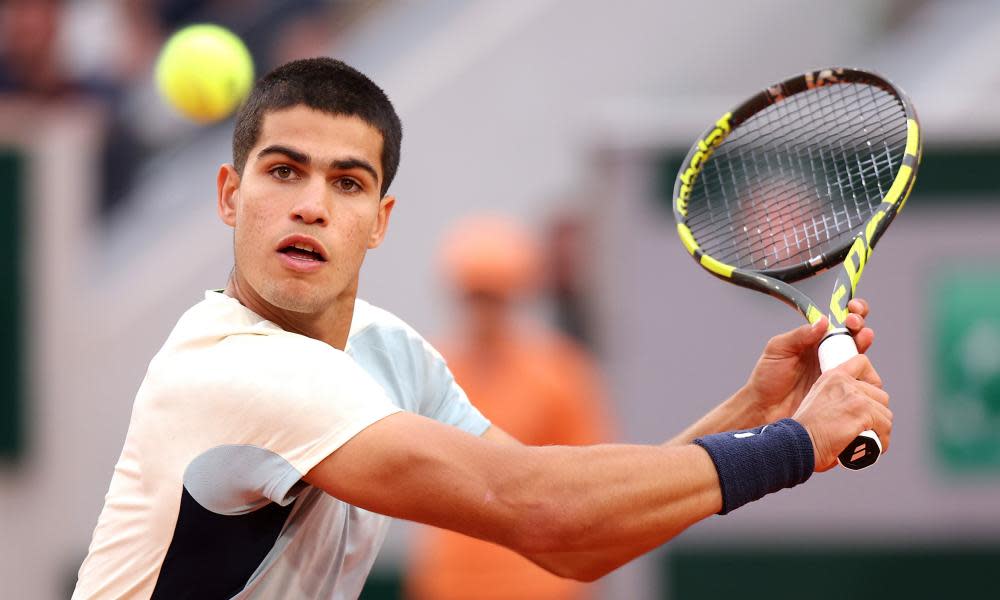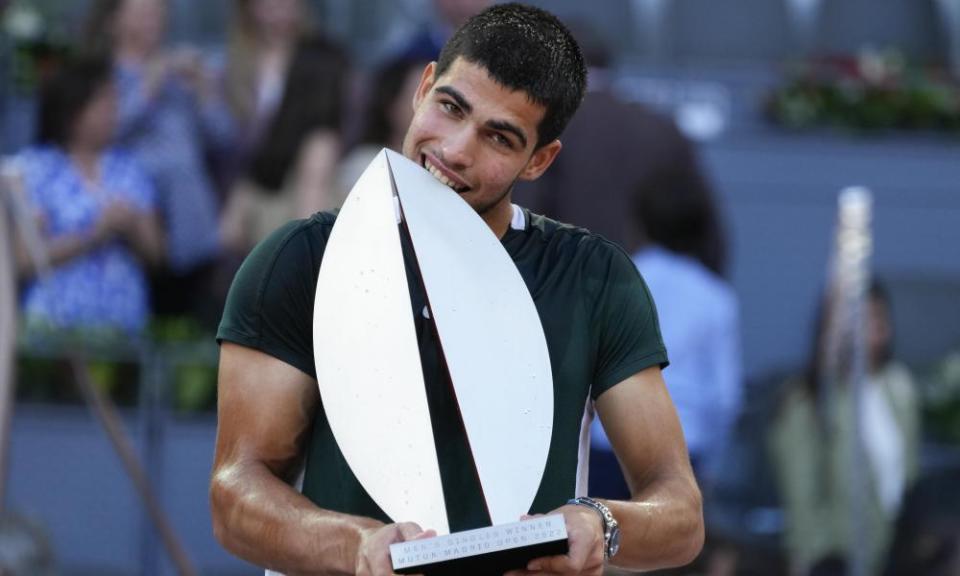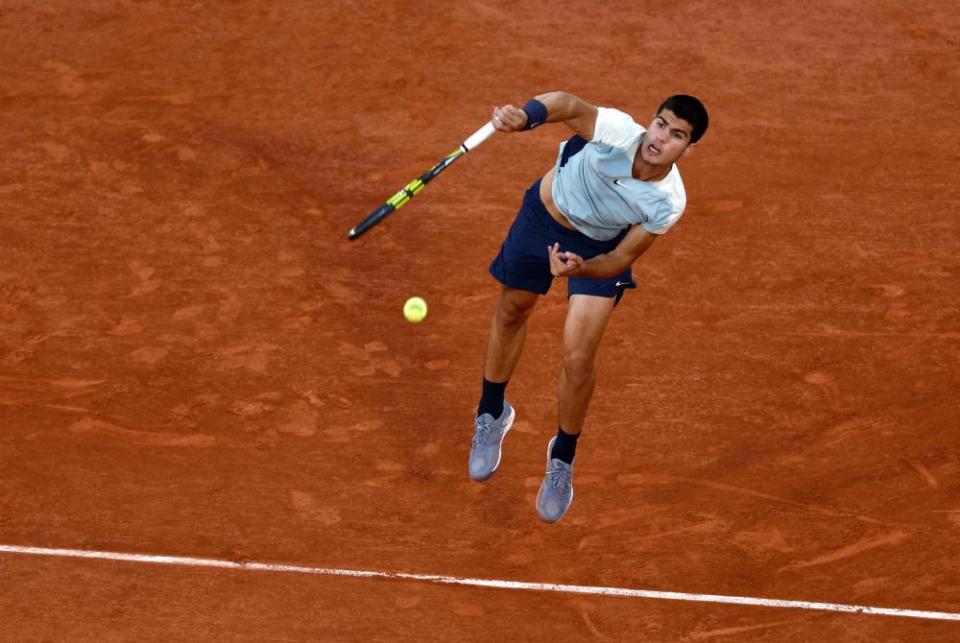No escaping Alcaraz: why teenage sensation could be next big thing

For over a decade, men’s tennis has been searching for new stars to follow up the dominance of its big three; Novak Djokovic, Rafael Nadal and Roger Federer. New generations have risen and fallen, waves of hype behind some promising young players have long sputtered out, while other extremely talented players have simply not measured up to their dominance. Deep into their 30s, Nadal and Djokovic have remained the safest bet to win most grand slam titles in recent years.
In the twilight of their careers, however, a new player has arrived who has positioned himself to succeed more than any other before him, the Spanish teenager Carlos Alcaraz. Ever since he won his first ATP challenger match aged 15, Alcaraz has had eyes on his tennis and expectations on his shoulders.
Related: Nadal and Djokovic remain on collision course for French Open quarter-finals
Alcaraz grew up in El Palmar, a neighbourhood in Murcia, southern Spain, and he began to play tennis at the Real Sociedad Club de Campo de Murcia where his father, Carlos Alcaraz Gonzalez, was director of the tennis academy. Carlos Alcaraz Sr was a modest professional himself, reaching a career high of 963 before retiring at only 20 due to a lack of finance. He has cultivated a tennis-playing family; Alcaraz’s 10-year-old brother, Jaime Alcaraz Garfia, is a promising young player in his own right who recently competed in the IMG Future Stars under-12 tournament in Greece. He has two other siblings; Alvaro, his older brother, and his younger brother Sergio.
In 2018, Alcaraz moved to the JC Ferrero Equelite Sport Academy, where he continues to live and is trained by Juan Carlos Ferrero, the Spanish former world No 1 who won the French Open in 2003, just a month after Alcaraz was born and right before Federer and Nadal began to dominate. With one of Spain’s greatest tennis players behind him, Alcaraz has progressed quickly.
At every age and stage of his young career, Alcaraz has remained above the curve, setting age records outright or following closely behind many of the prodigious achievements set by a teenage Nadal. After becoming the youngest US Open men’s quarter-finalist in the Open era last year, Alcaraz arrived in the new season having transformed his physique, donning a sleeveless shirt at the Australian Open to emphasise his gains.
It has taken him to the next level. By winning the Miami Open, Alcaraz became the third youngest player to win a Masters 1000 event, the second most prestigious tier of tournaments behind the grand slams, and last month he became the first player to beat Nadal and Djokovic back-to-back on clay en route to winning the Madrid Open.

King Felipe of Spain watched Alcaraz defeat Nadal in Madrid, having personally congratulated the teenager after his success in Miami. “I was more nervous [for] that call than the match,” Alcaraz said at the time. “It’s pretty amazing that the Spanish king congratulates you on the hard work that you put in every day and your win.”
Between those two Masters 1000 titles and two other third tier ATP 500 victories, Alcaraz has compiled a 30-3 record in 2022. After being ranked 133 at the beginning of last season, he is now the sixth-ranked player in the world at 19.
“He definitely is special,” Djokovic said this month. “I mean, already he’s breaking a lot of records as a teenager, you know, winning two Masters events this year, a couple of 500s. So far he’s the best player in the world, no question, this year with the results that he’s been doing.”
His popularity has naturally exploded. After his triumph in Madrid, Alcaraz returned home to Murcia where a sizeable crowd congregated outside his parents’ apartment, leading him to step out on to the balcony and brandish the trophy to adoring fans below. He has been invited to Spanish chatshows and covered prominent magazines. His Instagram following has crossed 1.3 million and counting. His matches were already attracting notable crowds at the Australian Open in January, but in Paris even his practices are the site of frenzied audiences.

Alcaraz’s success stems from a game that is more explosive, dynamic and complete than most players his age. He already has one of the most destructive and heavy forehands in the game, while his drop shot, particularly on his forehand side, is one of the central points of his game.
His vast hand skills and shotmaking talents are strung together by his supreme athleticism and defence, qualities that have produced innumerable incredible points that have further underlined his talents. Since his triumph in Madrid, the hype surrounding Alcaraz has gone into overdrive, and he arrived in Paris tipped by some bookmakers as the tournament favourite.
At Roland Garros, his tournament nearly ended surprisingly early. In his second-round match against the intelligent, crafty Albert Ramos Viñolas he found himself match-point down on Ramos’ serve in the fourth set. Such is his penchant for the big moments, he not only saved the match point, retrieved the break and took the fourth set, but then recovered from a 0-3 deficit in the fifth set. Somehow, even as he nearly lost to the world No 44, his reputation grew.
While Alcaraz may be the safest bet among all young stars to emerge over the past decade, even now that he stands as a top-10 player, nothing is certain when injuries, mental strife and other issues can impose themselves on careers. There is no doubt, though, that he is on track regardless of whether he fulfils his grand slam ambition as soon as this year’s French Open.
“I’m still young, but I would say pretty experienced player now,” said Alcaraz. “I feel comfortable playing on big stadium, big matches, playing on grand slam. Physically I’m strong. Mentally I’m strong, as well. I think I’m ready to play these kind of matches in these situations, these tournaments.” Then he shrugged. “I’m ready, yeah.”

 Yahoo News
Yahoo News 
